We’re getting close now. Close enough to list the things that have gone wrong on this passage.
Blown our Code Zero sail. Would have been nice to have, but really wasn’t a big deal. Will look at getting it repaired, but realistically I think we may be due for a new jib and new Code Zero sail. If we’d really wanted to, we could have probably tried to effect a repair ourselves, but it just wasn’t necessary.
Port alternator overcharging/regulator not working. This has turned into quite a big problem, mainly because we could have really used that charging capacity due to our refrigeration issues.
Freezer and both refrigerators have never cycled off. Working properly these would probably cycle off at least half of the time. Refrigeration is already the biggest power draw on the boat, but now it is doubled, or perhaps even tripled. Keeping the batteries at a good charge has been a struggle.
Silt in water tanks. Should have thought about this in Mexico where I could have easily cleaned them out. Now, the silt gets into the lines and clogs everything up. I’ve had to clear the filter on the water pump almost daily, as well as the filters on everything else like sink faucets, showers, and washing machine.
Fried water pump. The silt seems to have killed the water pump. Fortunately, I had a spare I was able to replace it with. I also found a second inline filter with that and was able to put that on as well. With two pre-filters things have been behaving better. The ultimate solution, though, is to clean out the tanks, and install a proper large, 20-micron can filter inline.
Running lights burnt out. This is on top of the mast, so when it stopped working on about day five there wasn’t much we could do about it. We’ve been running with the steaming light on instead. That’s Ali’s doing. Myself, I would have just run dark. There’s nothing out here, and if there is, AIS would spot us.
Two water leaks in Lowe’s room. One coming from the roof somewhere. That one requires dropping the ceiling panels to try and find it. Not a good job while underway. The other is in the small Lewmar hatch window that is inset in the large side window in his room. Probably just need a new seal.
Leak from an above the waterline thru-hull. I believe it is from the kitchen sink. Need to assess from underneath the boat to figure out what’s going on there.
Bilge pumps. That leak is causing water to get in the starboard bilge. This is when it dawned on me what a glaring flaw this boat has. On every other boat I’ve ever owned, the bilge pump was set in a “well” inside the bilge. In other words, a small box sits deeper than the bilge itself (generally set down into the keel I suppose). This way, when even a small amount of water enters the bilge it goes down into the well, where the bilge pump is located, and it gets pumped out. Easy-peasy. On this boat, there is no well. So the bilge pump just sits on the bilge floor. It would likely take at least 50 gallons of water in the bilge, sloshing back and forth before the bilge pump kicked on. And even then, it would only get a small amount of the water out, since a bilge pump can’t suck the water dry right down to the surface of the bilge. I’m quite amazed that this design flaw got through on a boat like this.
And that’s about it. Fortunately, nothing in there that was dangerous or kept us from having a good safe passage. The power issue is our most critical right now, though, as it makes living normal life on the boat nearly impossible. At the moment I’m not sure how I’m going to solve any of it without the parts that I would normally order up and install in a day or two.
Another rather ridiculous design choice with this boat. This is a picture of me emptying the water pump’s filter. Yes, the water pump is located directly alongside a wall of electronics. Seriously?
Nice beam reach. Wind too far forward for the Parasailor, unfortunately.
Congratulations to Lowe. This time.
This boobie joined us for the night. Then took off the next day, but returned again for a second night.
We don’t drink coffee when on passage. For some reason we just don’t crave it. But Ali does whip up a big pot of iced coffee now and then.
Getting the reefs ready. Storm is coming quick.
We’d known for a week that we were going to get hit with some bigger winds. There was no way to avoid it, so instead for the past week we’ve been sailing further east than we normally would have. About 150 miles off the rhumb line, in fact. When the storm hit we were then able to turn off about 40 degrees further downwind, putting the wind and waves at about 120 degrees instead of the 80 they would have been at. On this boat, it’s infinitely more comfortable riding a storm out downwind rather than a beam reach. Winds hit 36 knots with this one and lasted a few hours.
The first storm passed, but there would be more to come.
The last couple of days before landfall would be spent mostly under triple reefed main and a sliver of a jib sail, reducing sail as much as possible to keep the boat going in the right direction and not feeling out of control as we surfed at up to 12 knots down the waves.
It’s notoriously difficult to capture the size of waves in a photograph. This picture was taken in 25 knots of wind and seas rolling up to about the twelve-foot mark on our stern quarter. When standing up and watching an approaching wave we would be staring back at the middle of it while we were in the trough. There is nothing better than a catamaran in a following sea, though. The rolling would have been unbearable in a monohull, yet we were all lounging around reading books.
There would be numerous trips north of 30 knots over the last couple of days, but those never stuck around too long. We raced downwind in 25 knots most of the time, and were able to bump up our ETA by twelve hours, which would erase another night at sea. Landfall coming in the afternoon.

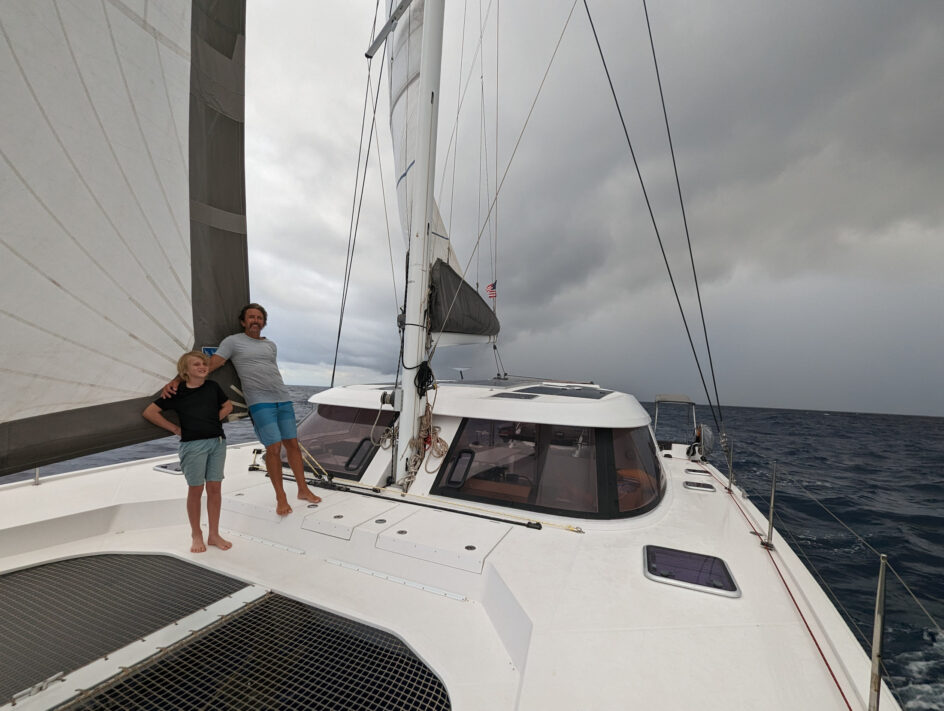
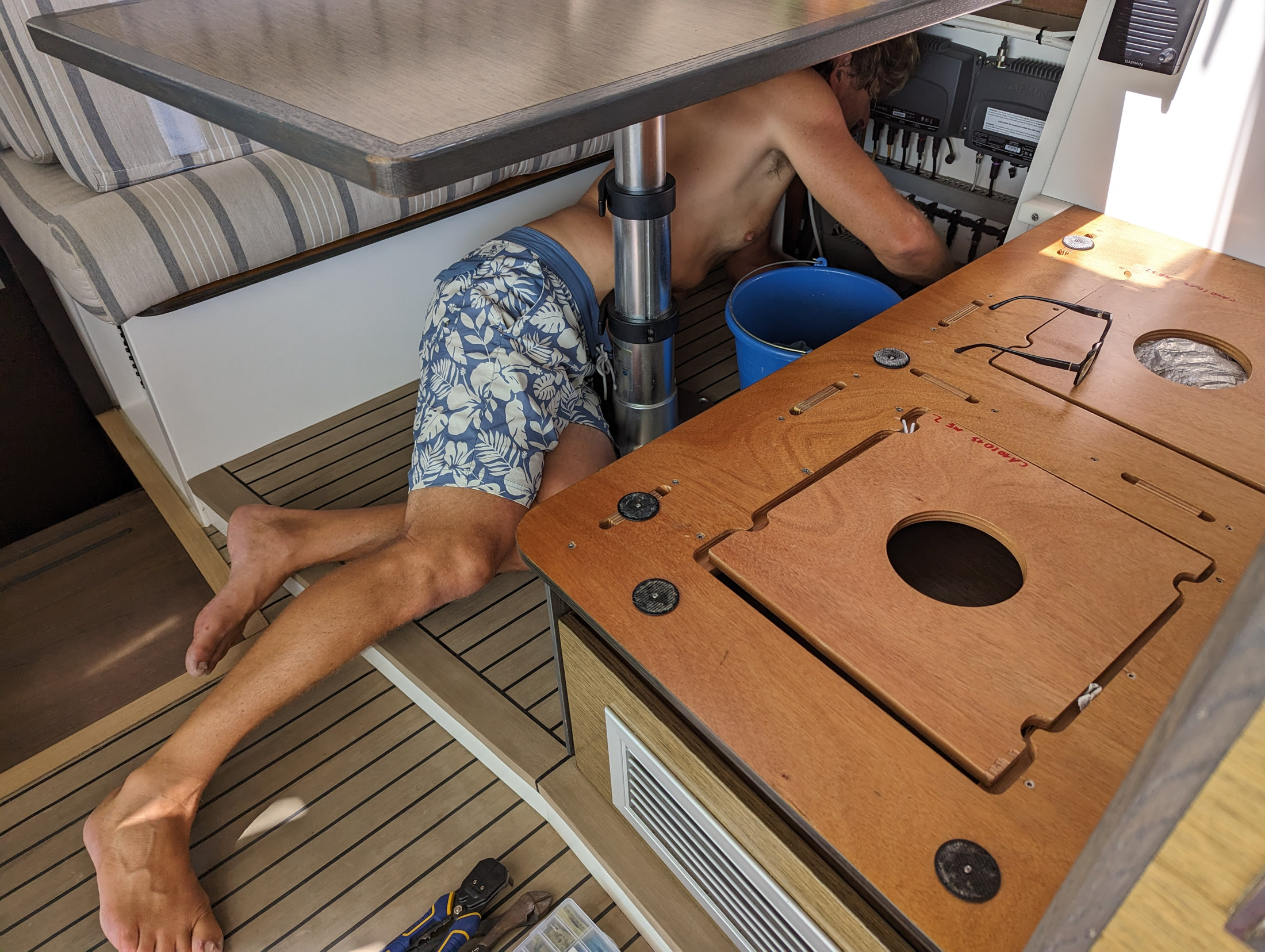
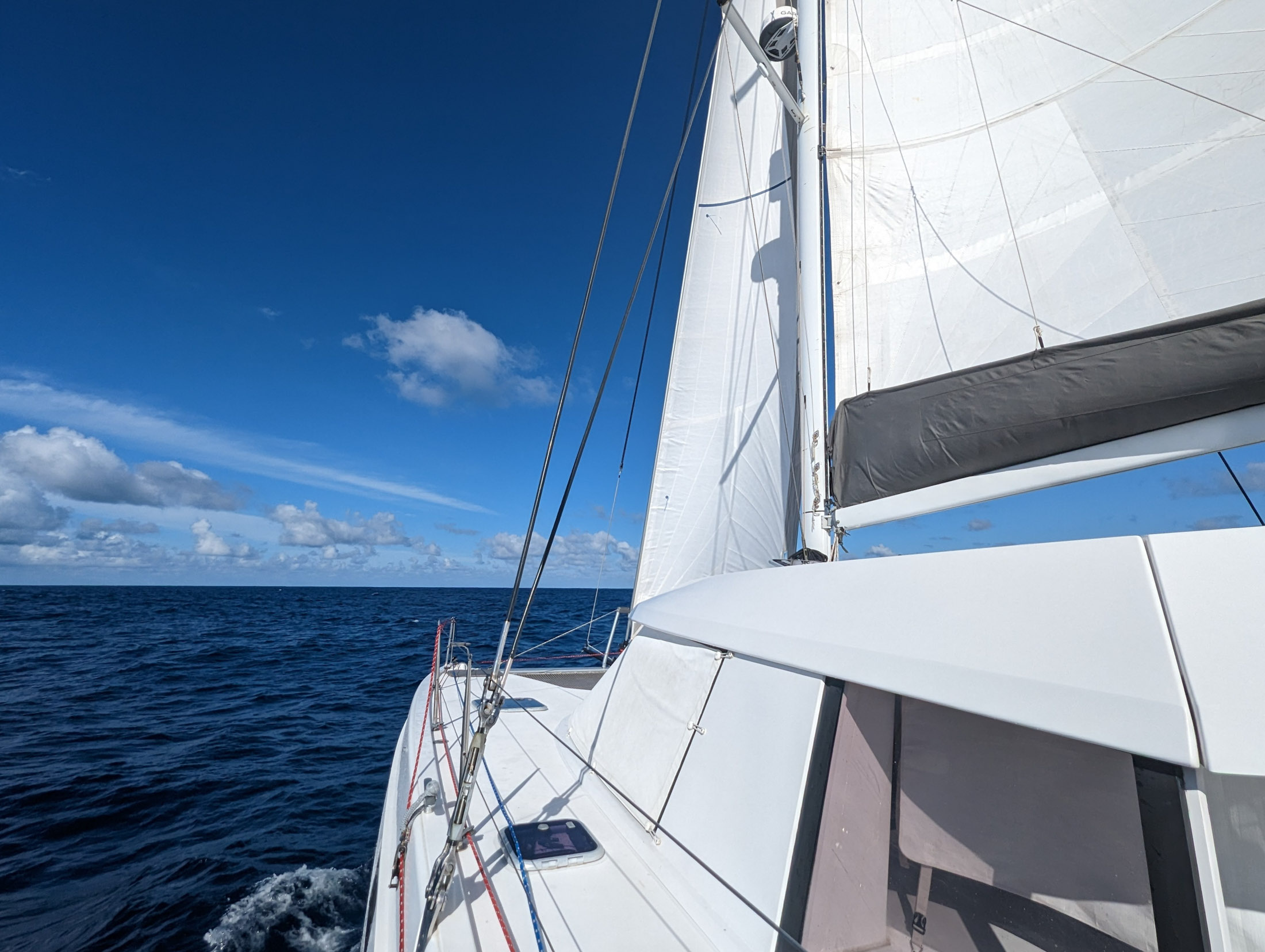
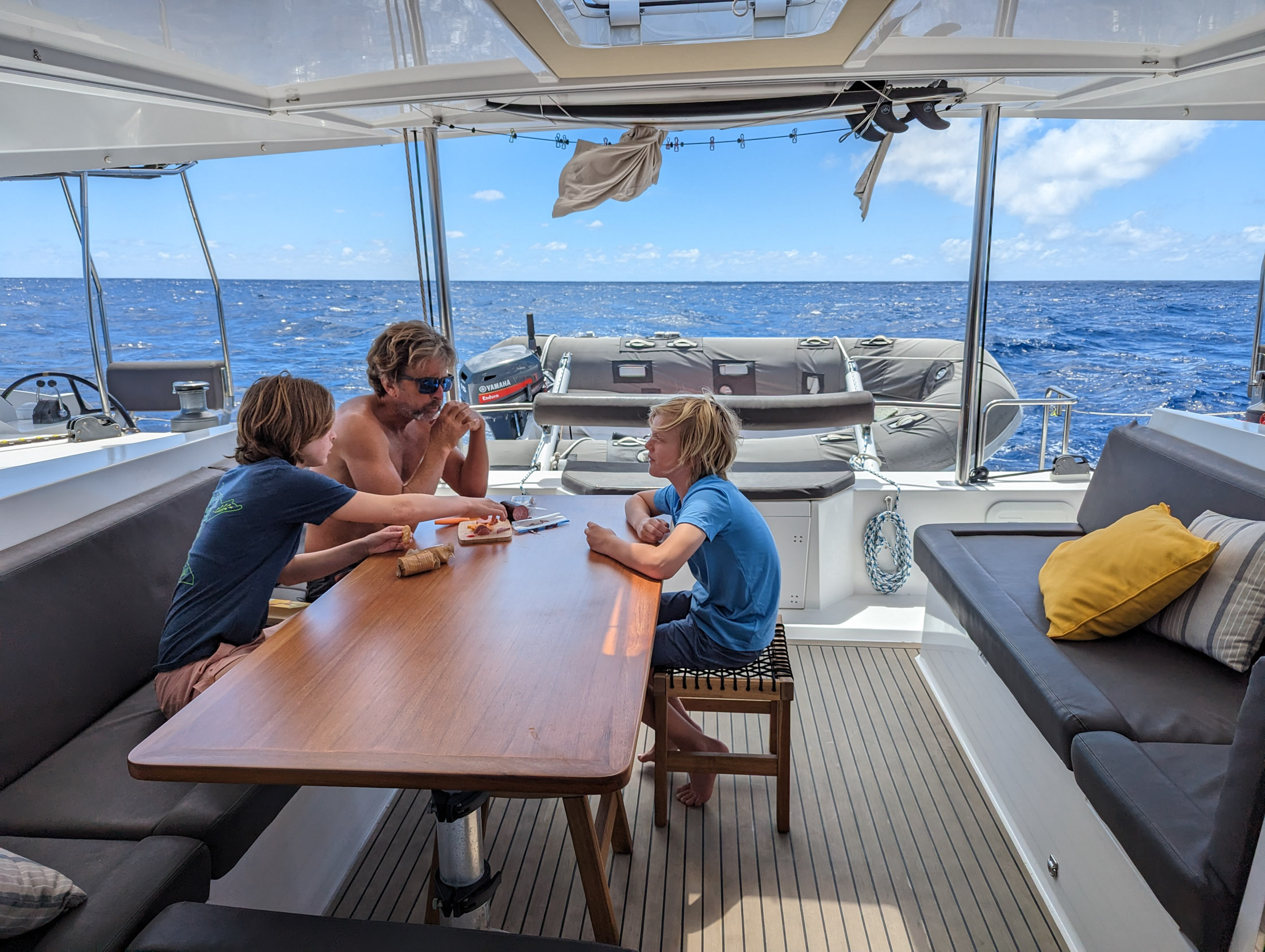
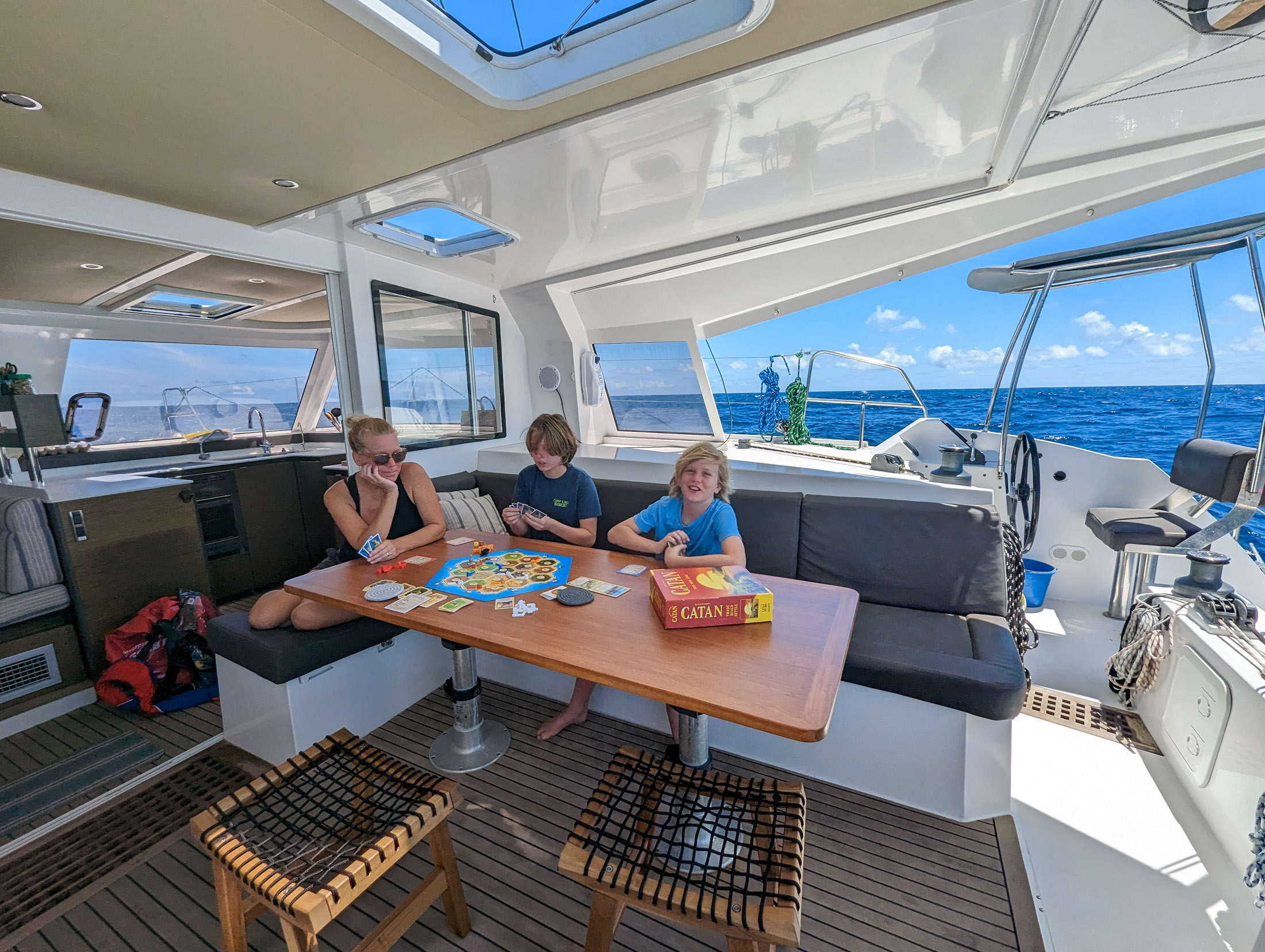
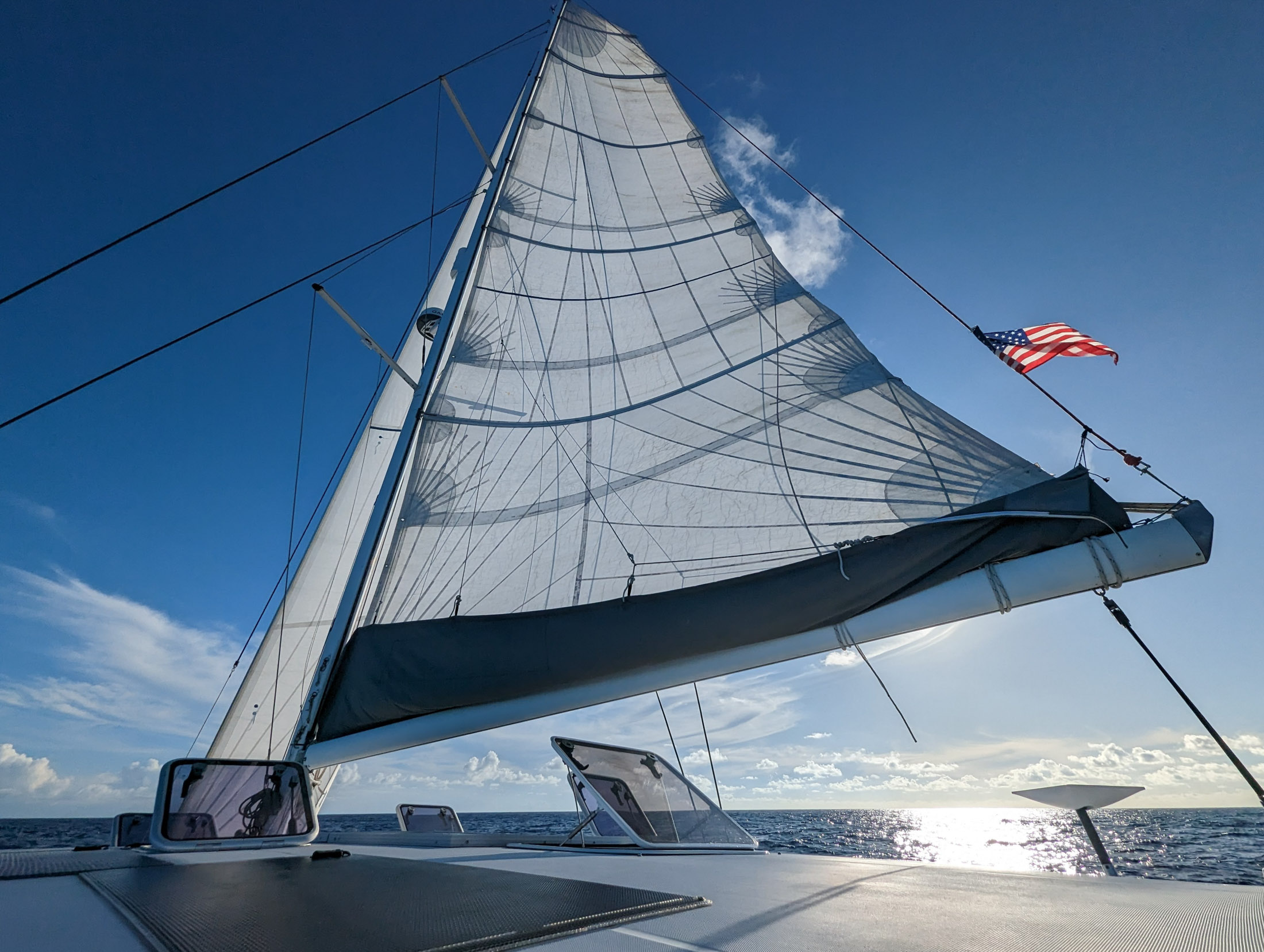
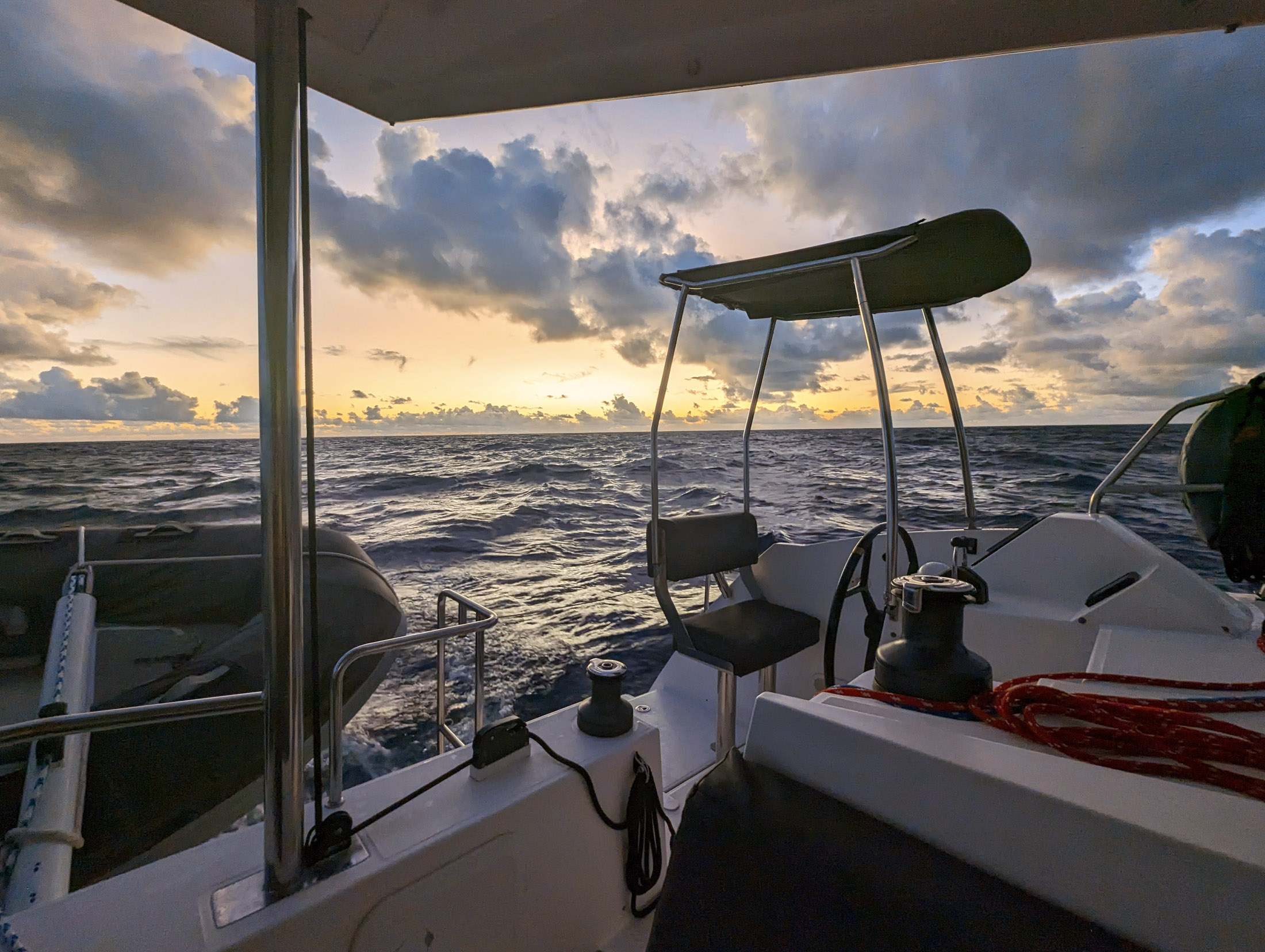
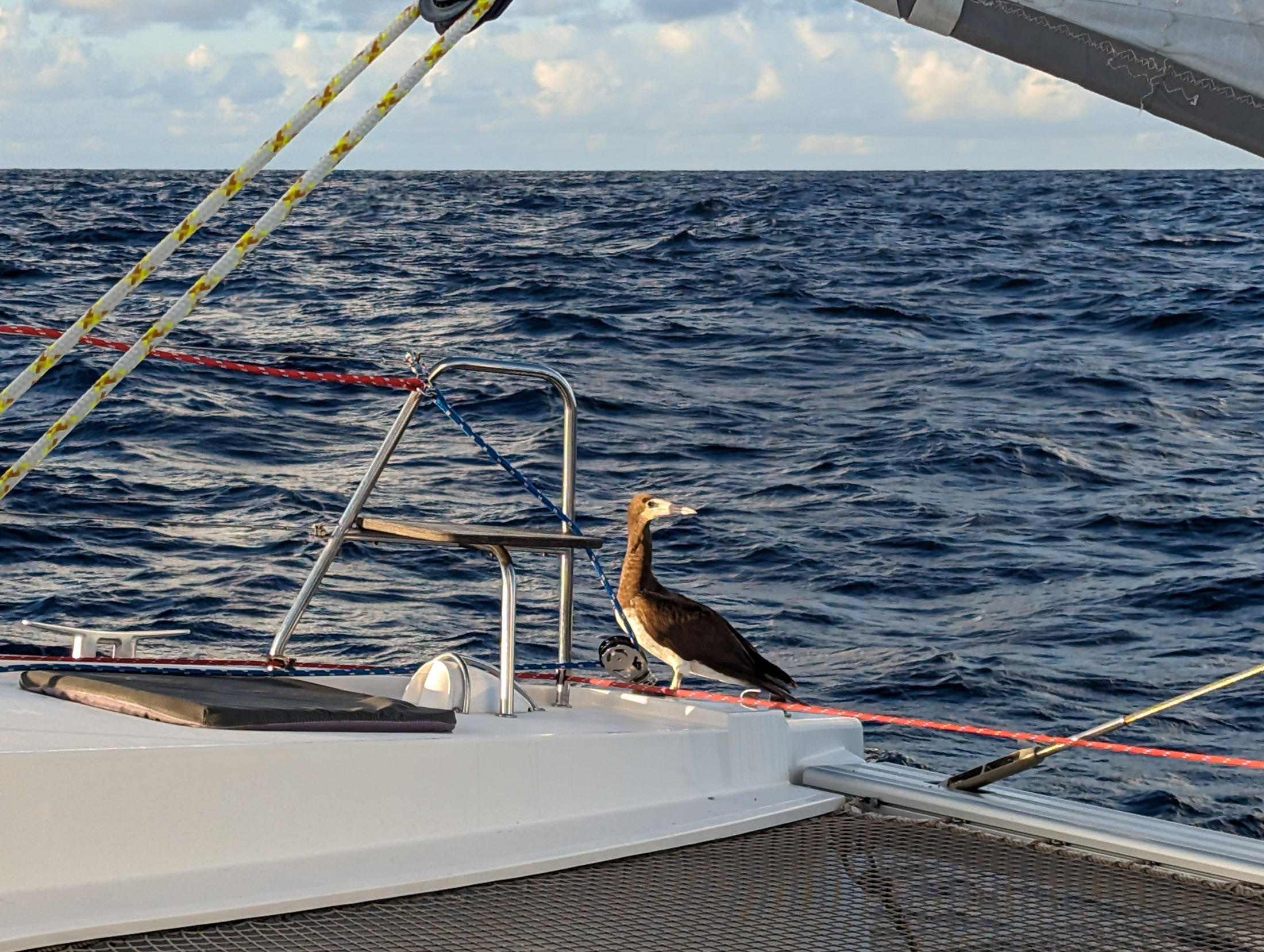
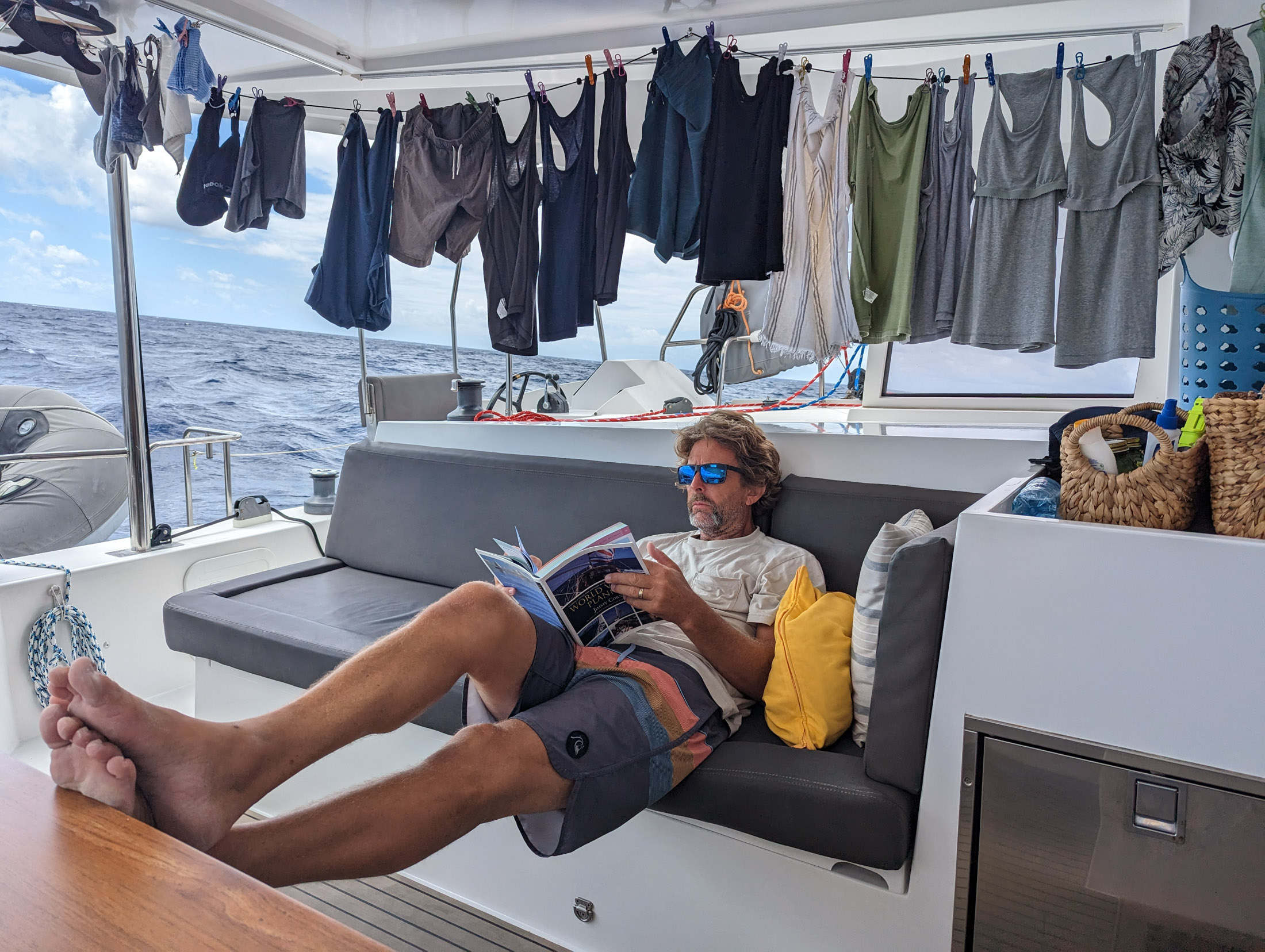
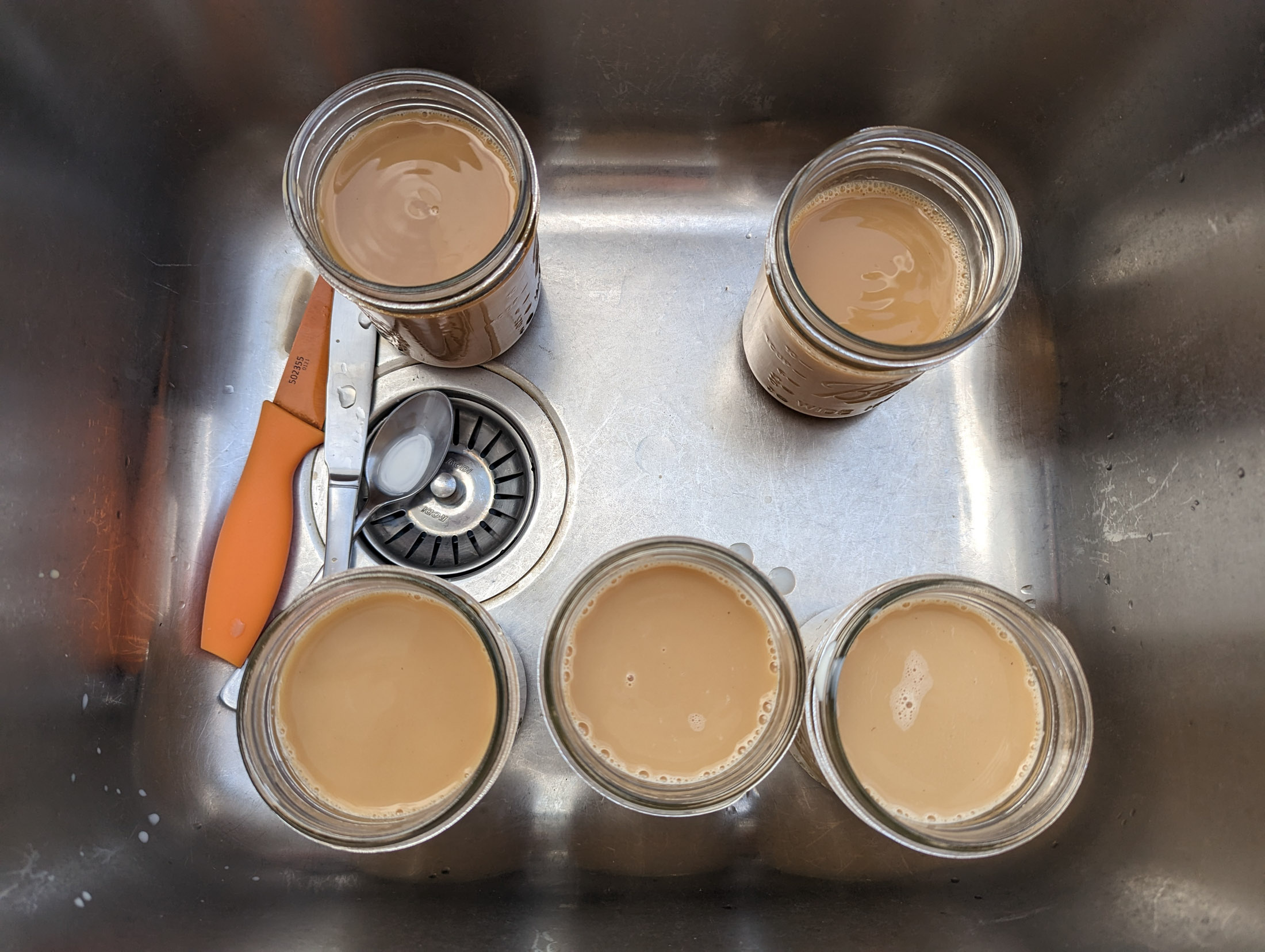
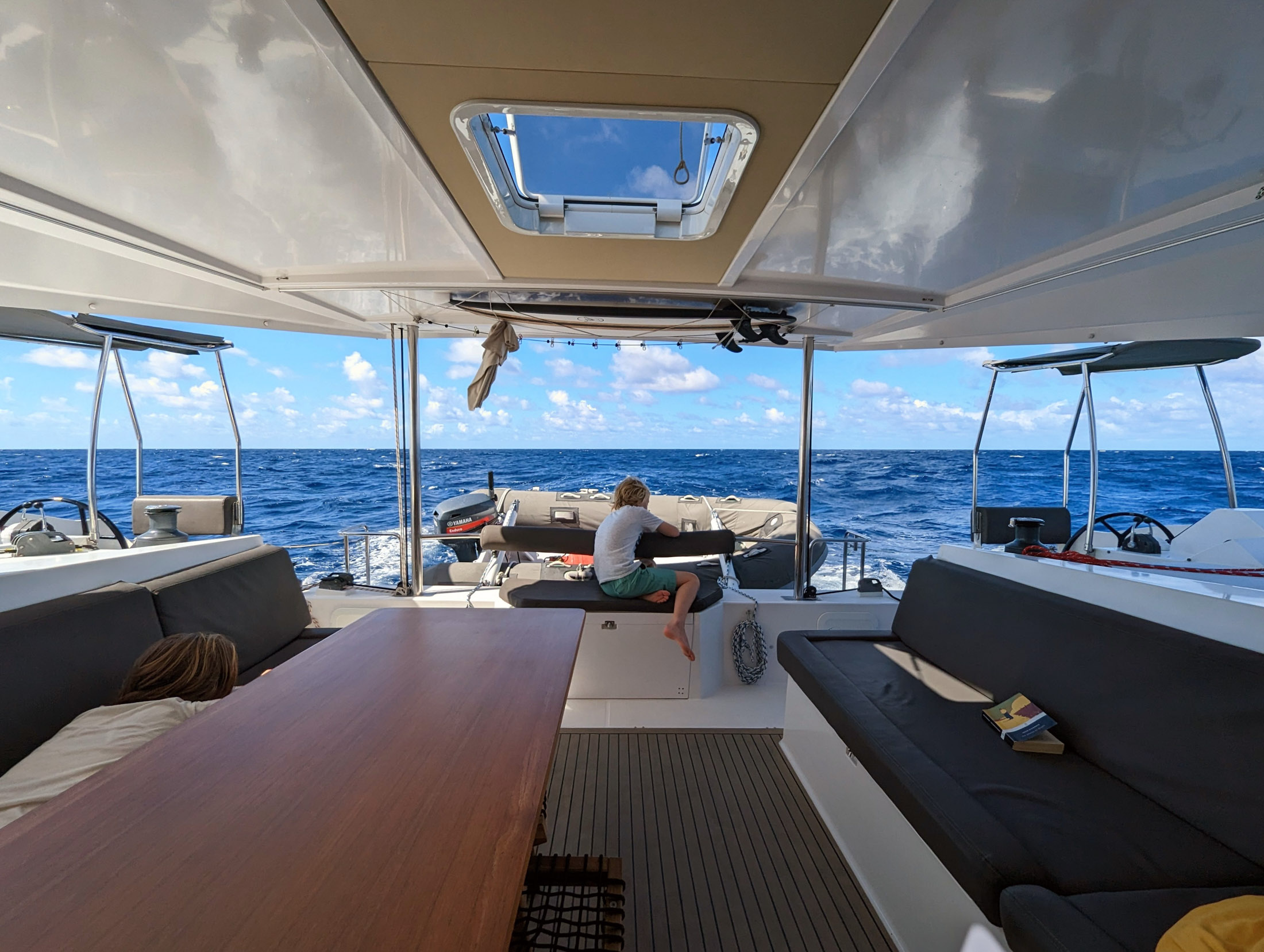
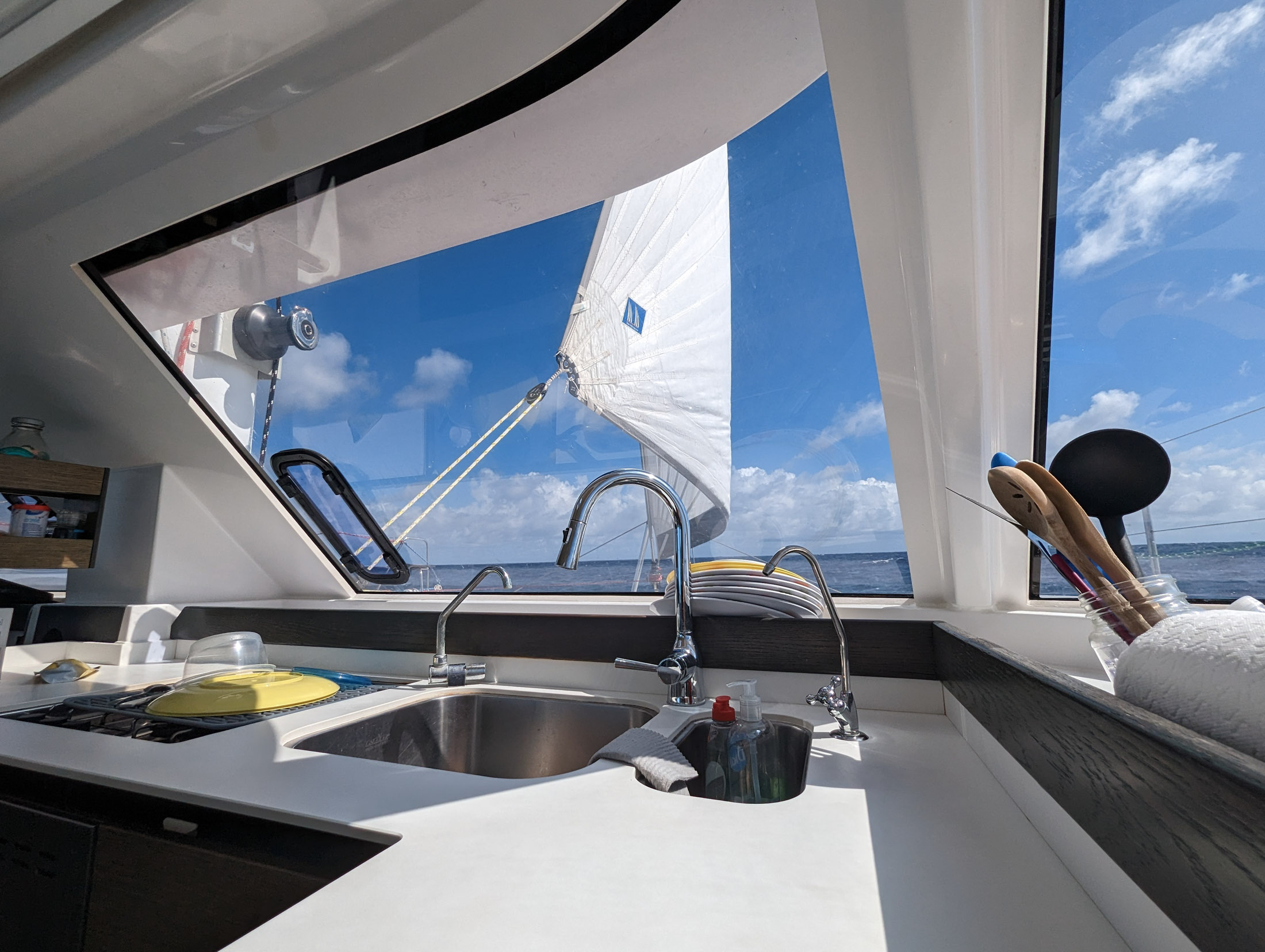
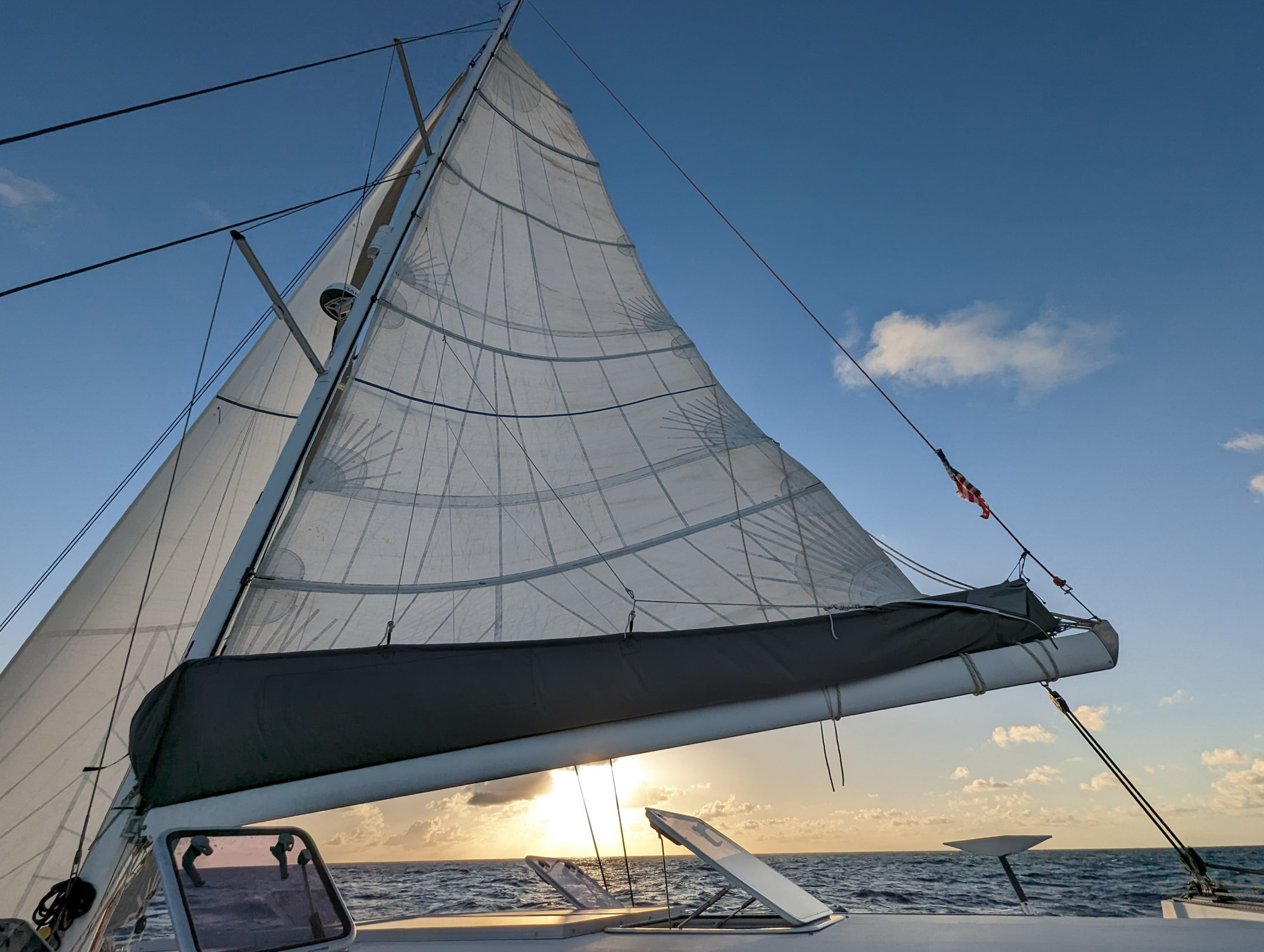
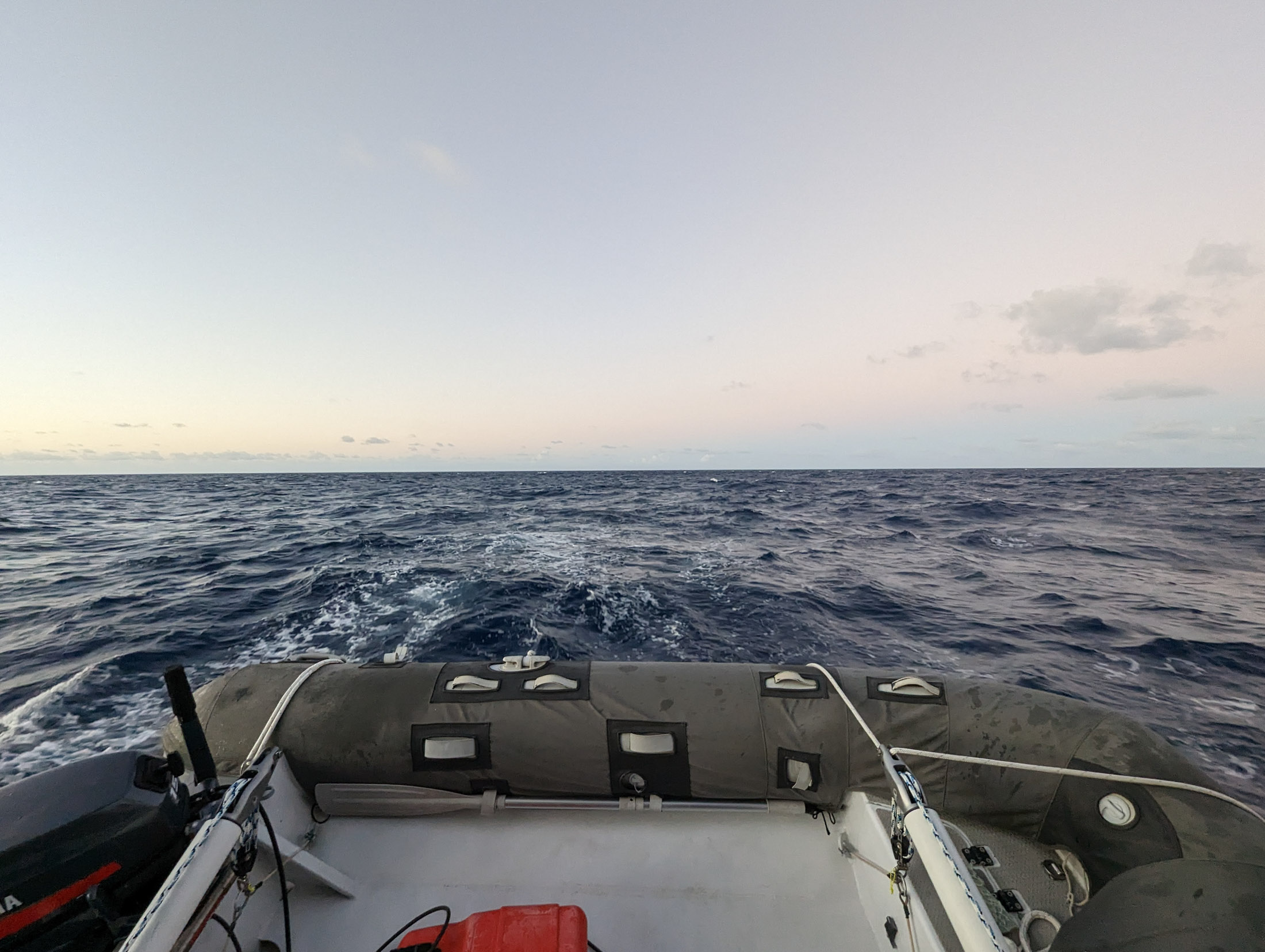
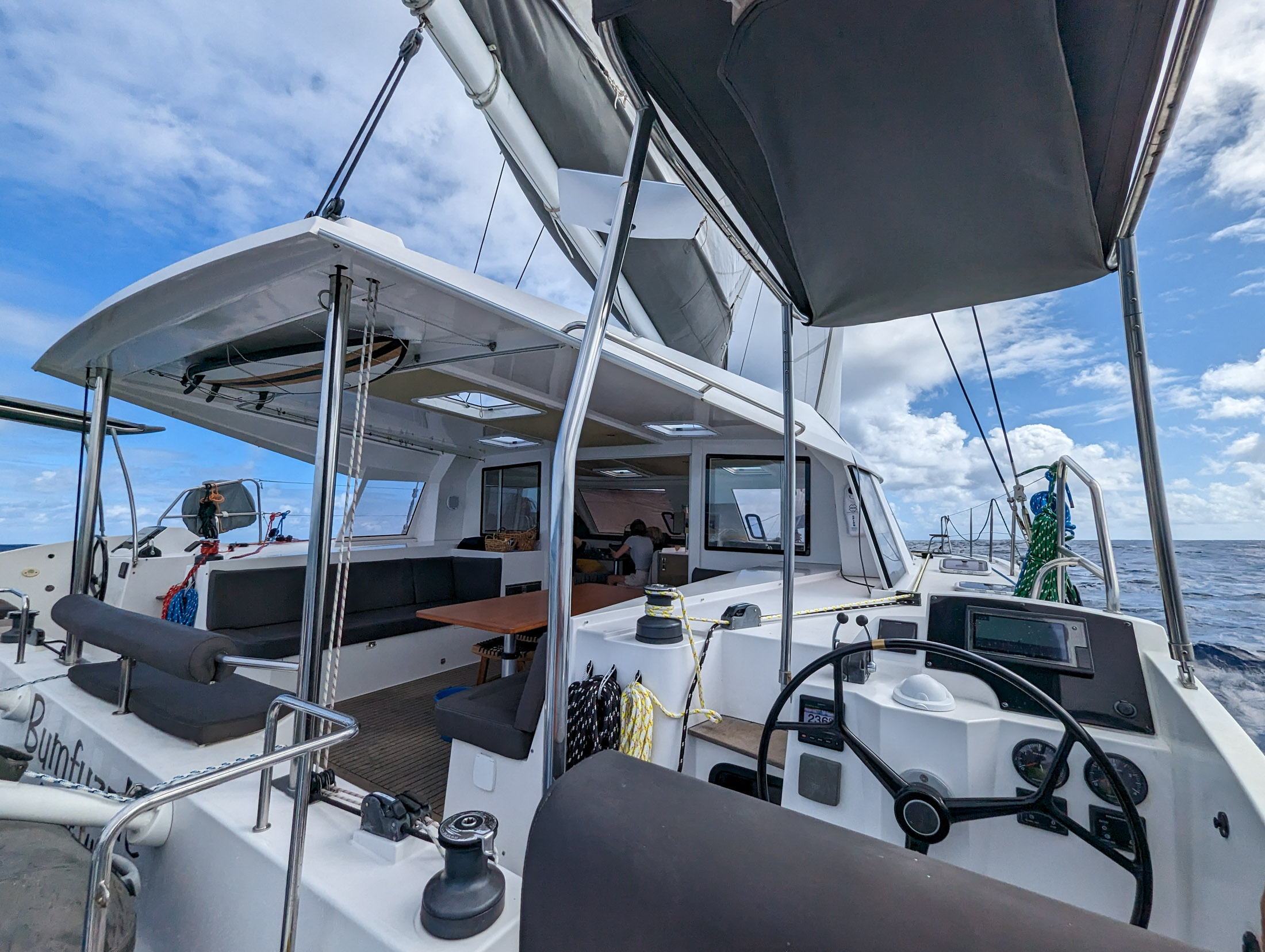
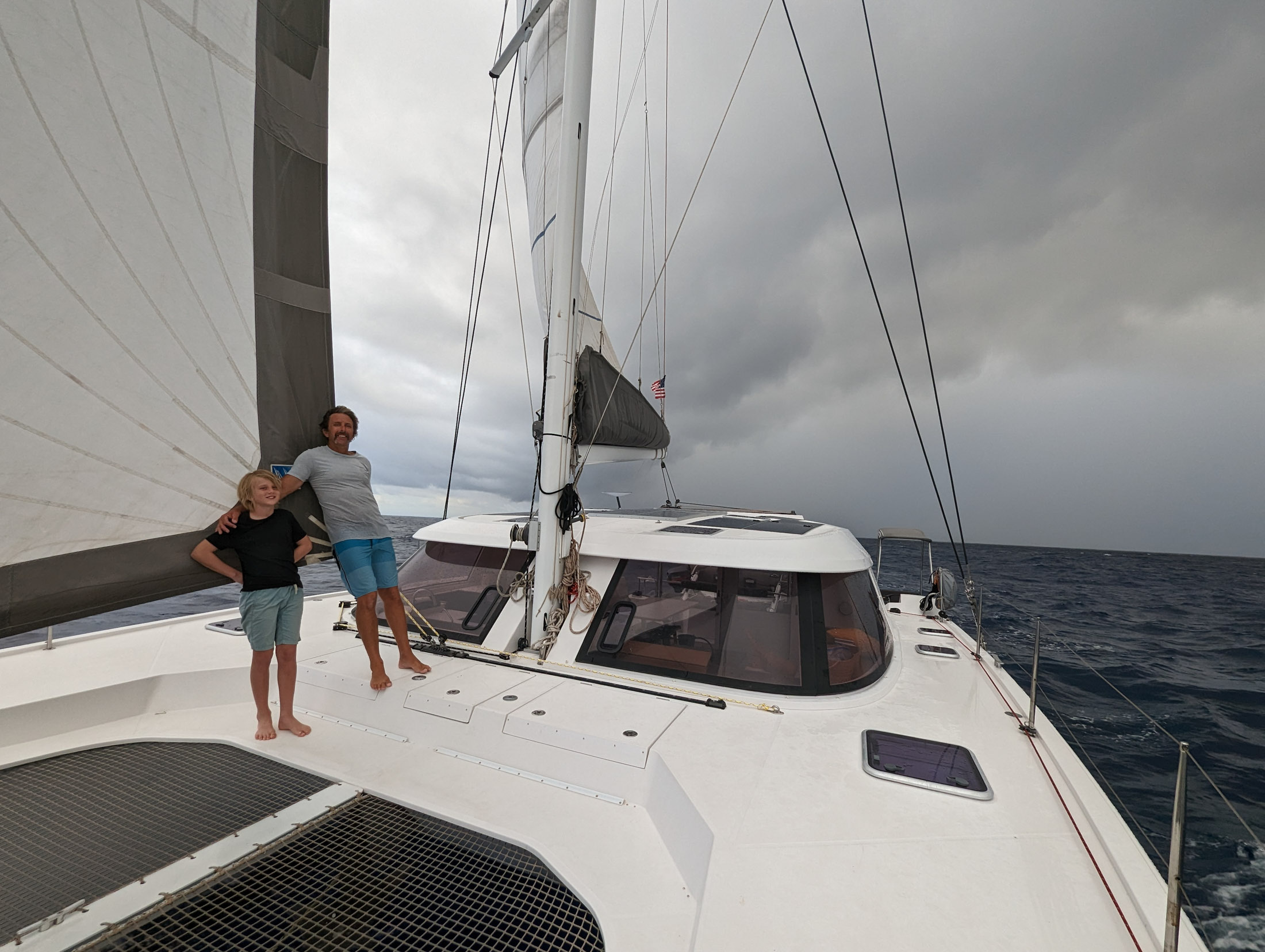
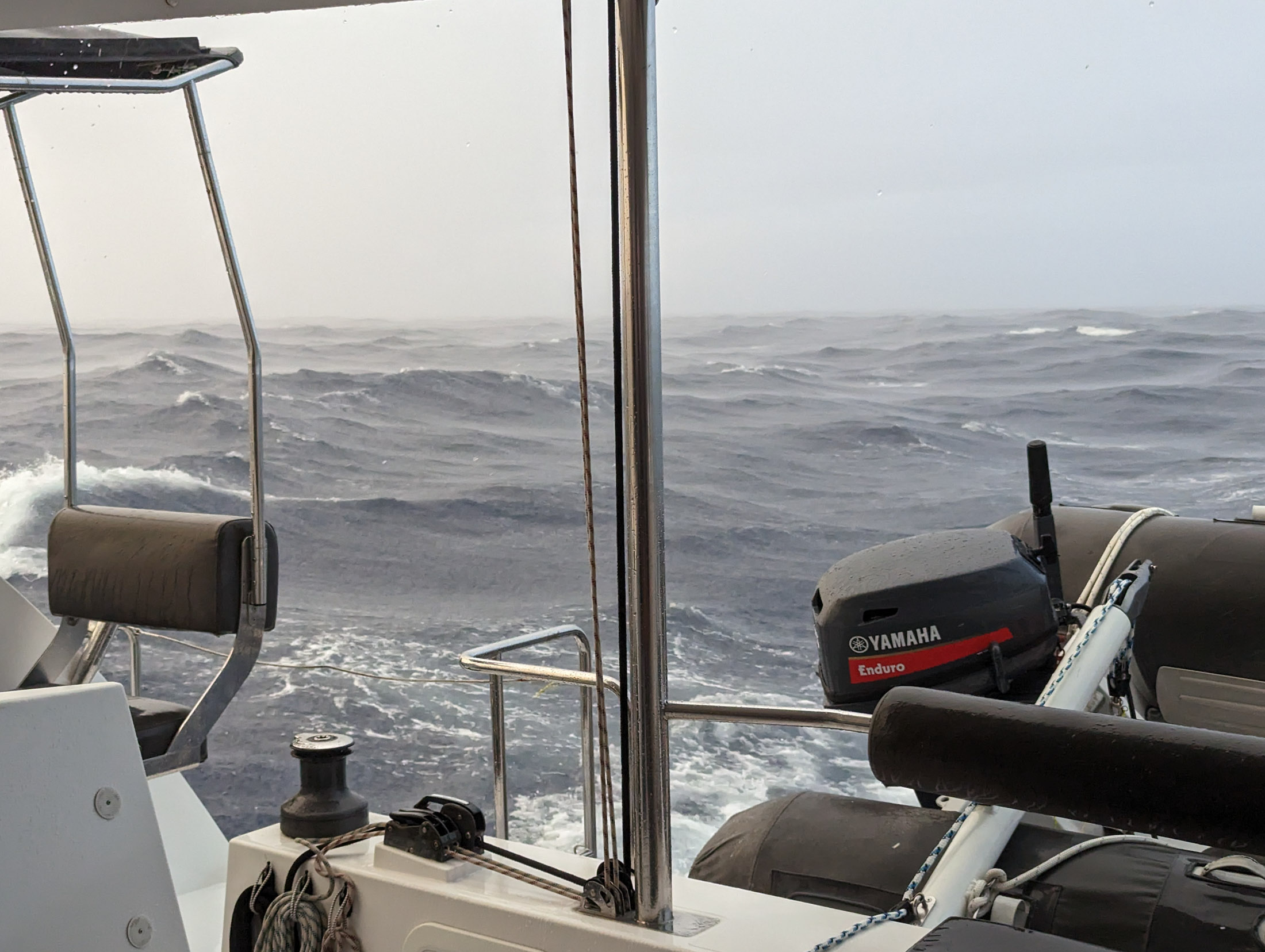
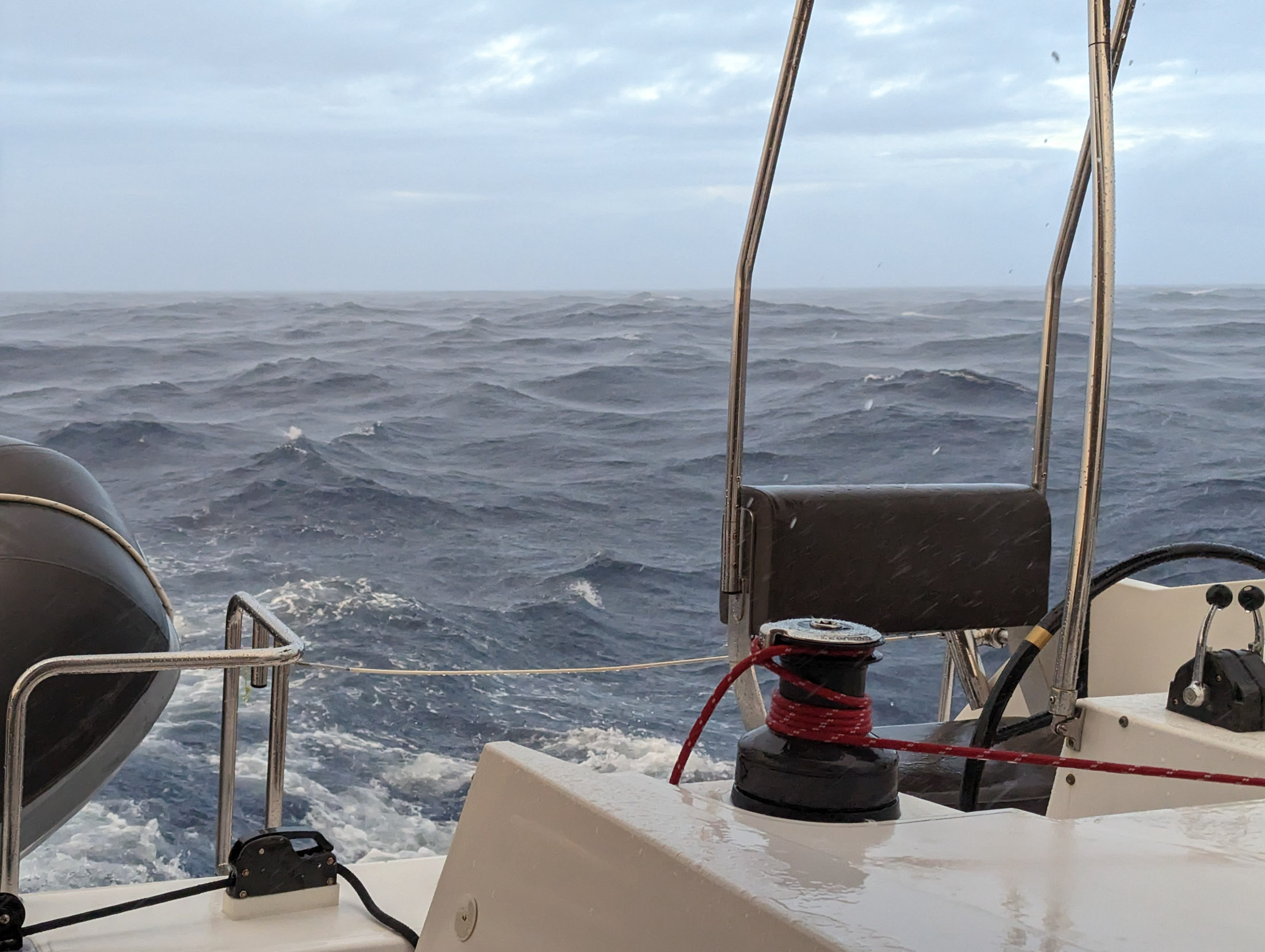
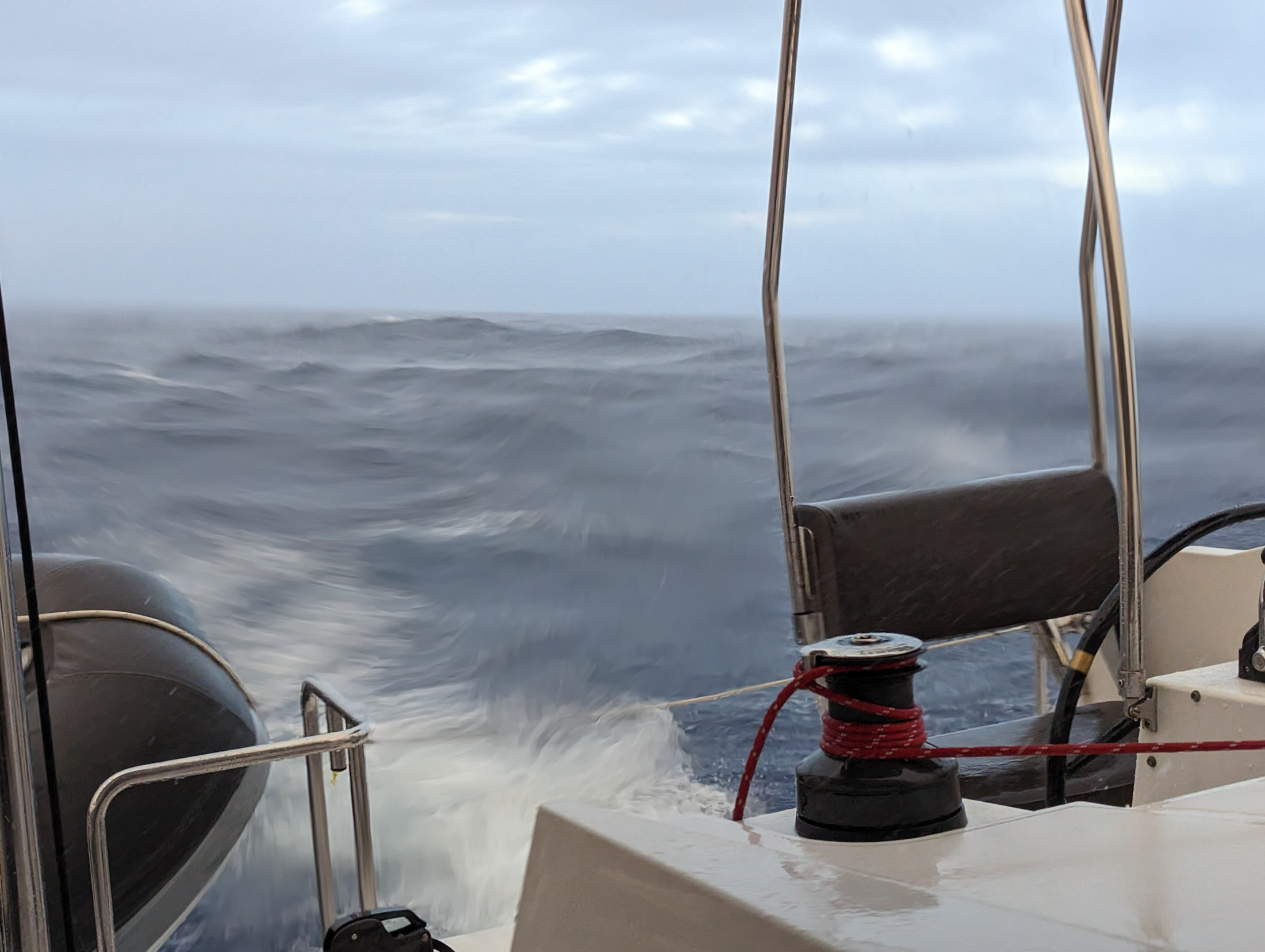
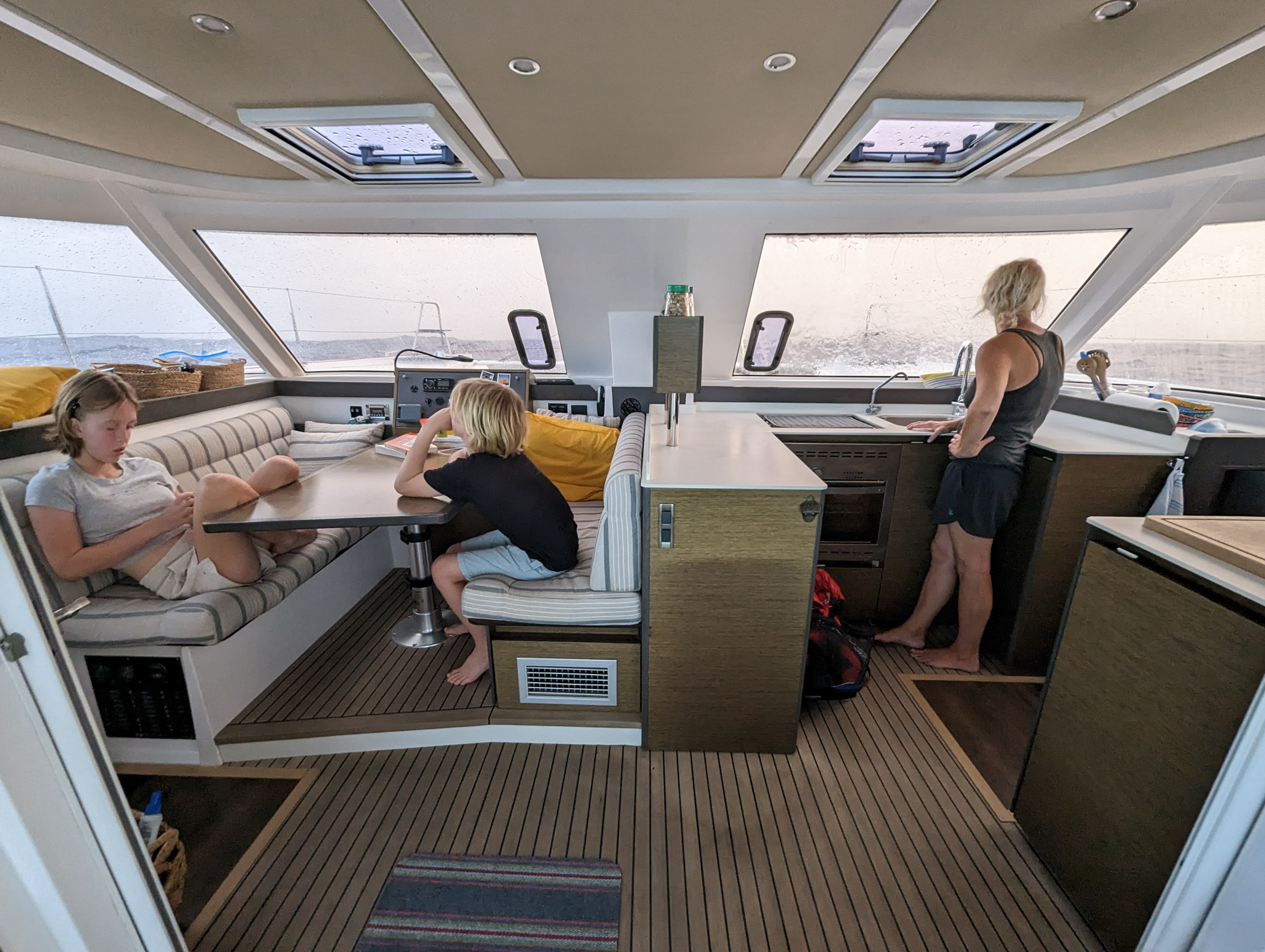
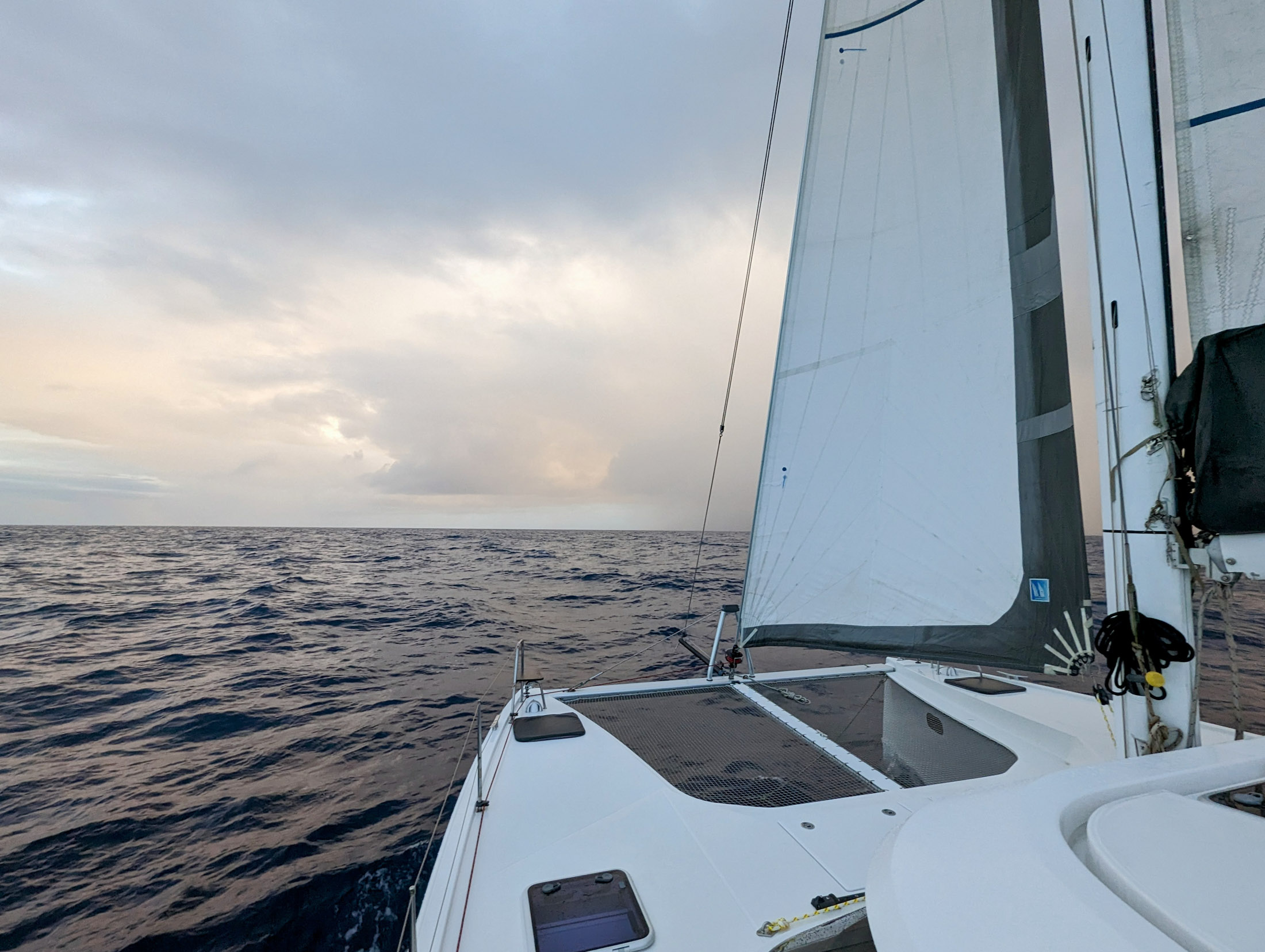
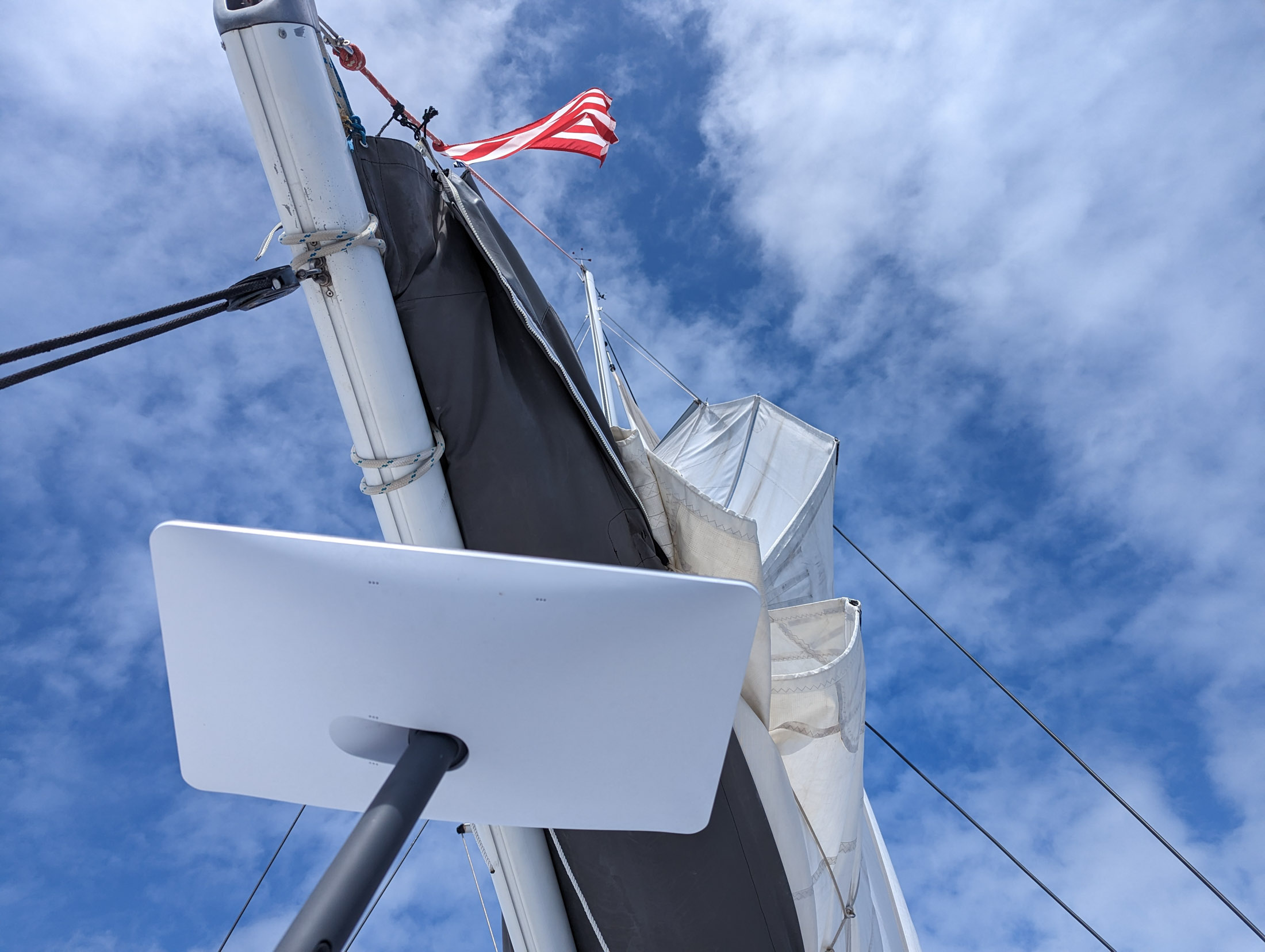
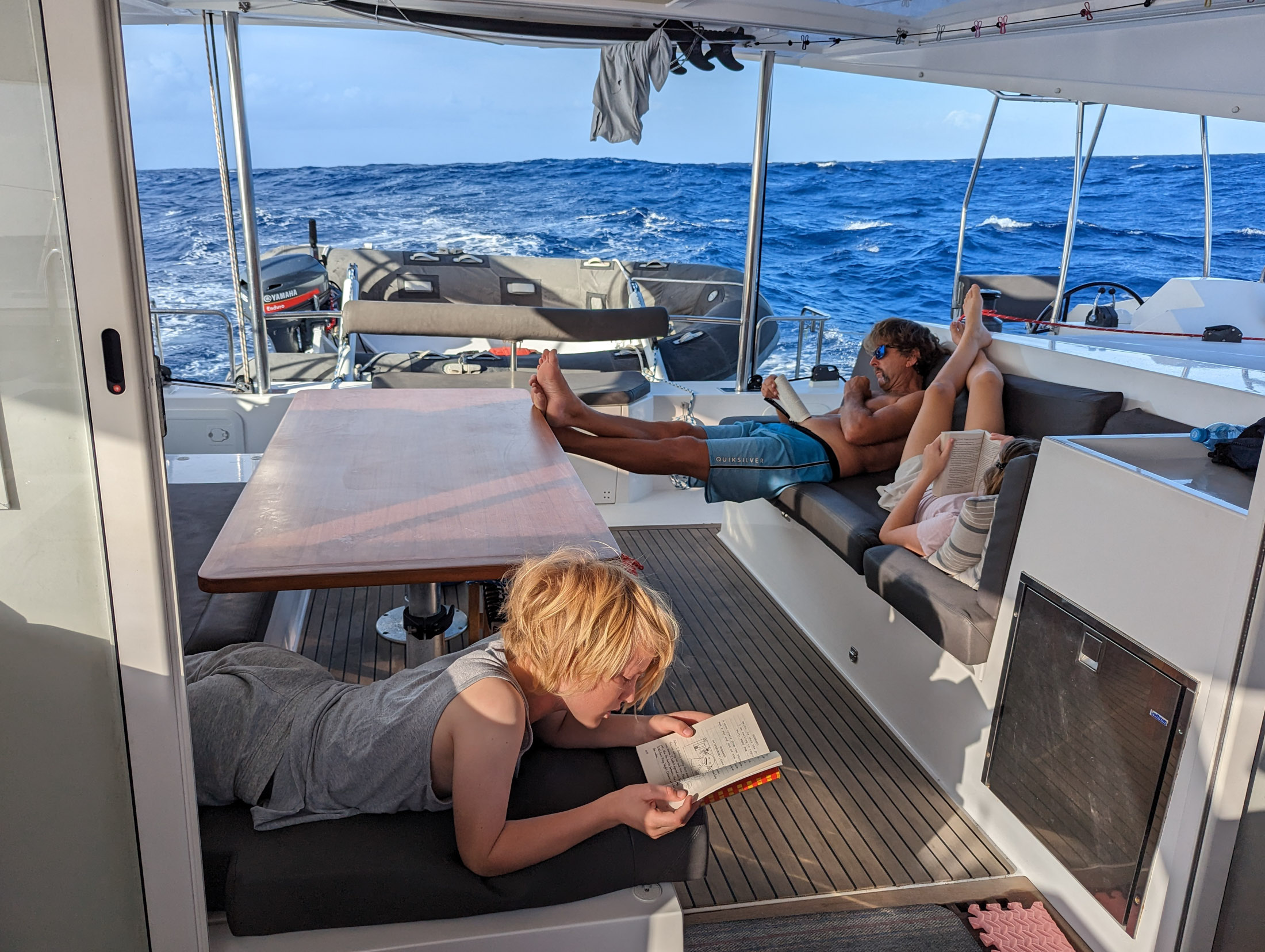
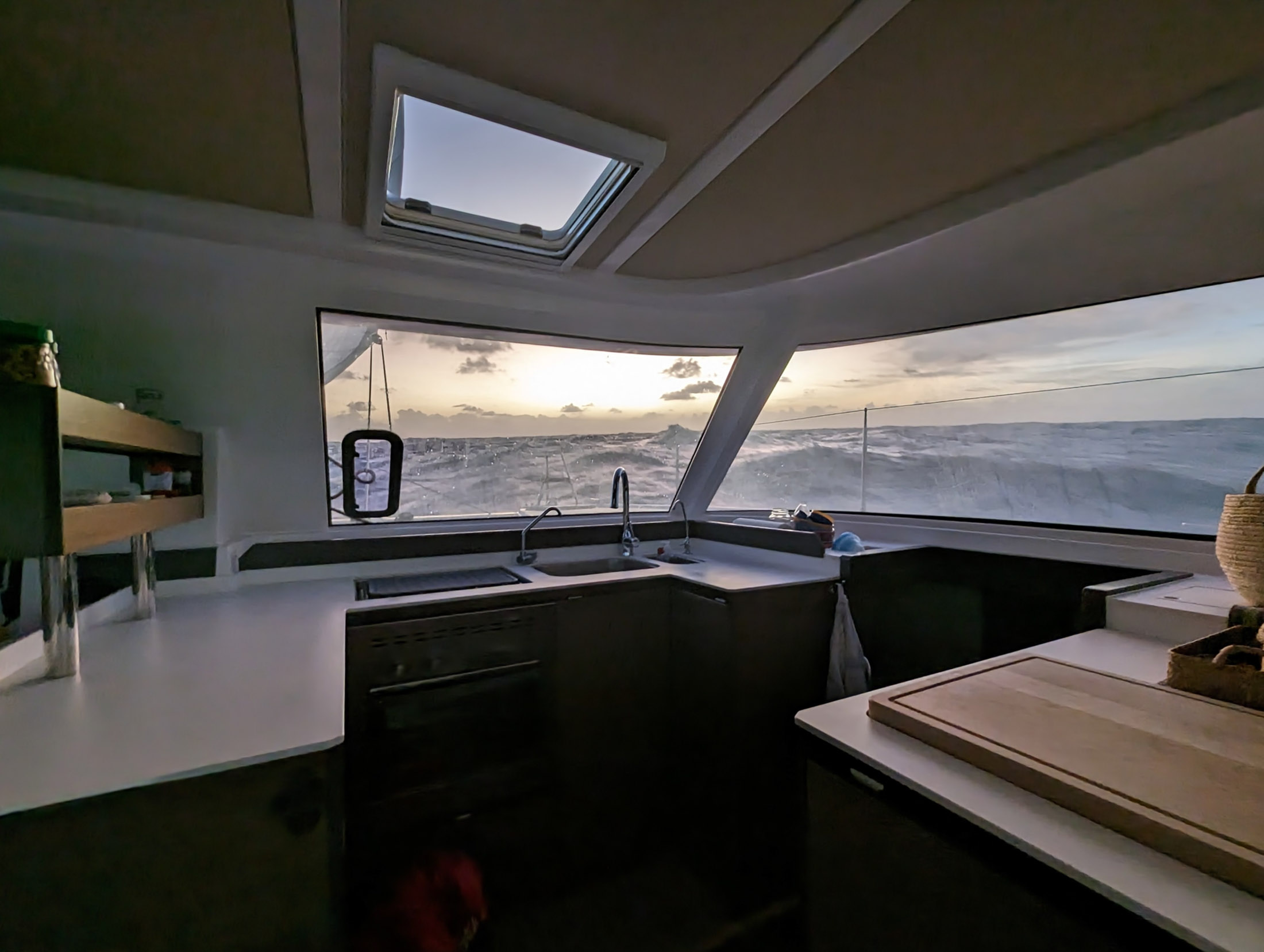
16 Comments on “The Dark Clouds”
Everything is logged into the big scheme of things. I think the boat is solid but… You have so much experience in blue water sailing. Trust your instincts, listen to a country crooner, like Elvis singing a Blue Christmas and evaluate your position. And keep your family informed. I do own a perfectly new Bumfuzzle hat that needs to be signed.
This may be of some help on the bilge pump question, but you are way beyond me in experience. The normal monohull bilge pump has a float, exactly like our house (my sailboats, 1979 to 1995). My trimaran (circa 1995) would have sunk because of a hole, but never would otherwise, so it didn’t have a bilge pump. It had me with a sponge. But cat’s don’t have that sunop place. Our Maine Cat circa 2000 had that smooth sailing shape with no sump. Each hull had a surface mounted Whale pump like the predecessor of this: https://defender.com/en_us/whale-supersub-smart-ic-automatic-bilge-pump.
It combined an intake that sat around 1/8 inch above the hull, and a electronic trigger. The idea was that when the water level was high enough to trigger the electronic gizmo, it would run until the trigger no longer registered water, but still long enough to suck down closer to the 1/8 inch level. Brilliant idea but not perfect. I went through six. A sponge was more effective.
1. It’s not a high volume solution, so a second bilge pump for a problem is necessary. But it could get you to the sponge part.
2. It’s not a high lift solution.
3. An intake sized to suck way down is vulnerable to minor clogs, like hair, the everpresent grunge and little plastic bits. So per #1, it might be an addition.
4. The electronics were finicky. The 2000 version in one hull lasted years, and in the other failed in a couple of years. The company failed and was acquired by Whale; they changed the electronics and then pulled the pumps off the market, then relaunched. That didnt’ work for me, and I switched to a different company. I see they have changed that part again.
In truth, I never really had water in the bilge other than condensation, when the sponge was fine. Except when I took a firehose and pressure washer to clean the entire interior.
Yeah, that’s the system that’s in place right now. On our other cat we did have a sump. The annoying thing to me is that the sump could be as little as one inch deep and it would do the job of keeping the bilge empty and dry. Sitting flat on the bottom of the bilge, the pump would both have to be located on the very lowest point, and you’d have to assume that the pump could actually draw it down to 1/8″, which they never do, and even if they do 1/8″ of water spread out over 30 feet or so worth of bilge is still a lot of water.
Great adventure! One thought on your refrigeration and freezer. Could you cycle them manually? Perhaps flip a breaker every once and while to turn off the freezer, assuming you aren’t actively opening it a bunch? Could save a ton of power. Could likely do this for the refrigerator as well, but might not work as well. Just a thought. Good luck on your adventure!
Yeah, we’re doing that, but setting alarms to remind yourself to flip breakers every 20 minutes is not much fun.
A simple and cheap solution may be to install a fridge controller like those used in homebrewing where fridges are used to control fermentation temps overriding their built in controller. Very easy to use, put the thermoprobe in the fridge and plug fridge into controller, controller into outlet. https://www.amazon.com/dp/B095WF94Z5/ref=sspa_dk_detail_9?th=1
Fridges are 12v DC power, though.
Hopefully you have used up the food in one fridge already and have that turned off, which will help the situation a bit. Turning them off at night, and not opening will also help, as long as it it not too hot at night. Not a long term solution though.
The cockpit looks like a terrific spot for a long ocean passage. Lots of room for everyone to spread out, lots of shade.
Ugh we have the same bilge situation on Brio II — gives us HUGE appreciation for the beautiful deep bilge that baby Brio had 😉
Jon’s spent endless hours working on an “arid bilge” setup (you can Google better details than I can explain, but basically a series of sponges connected to tiny hoses, placed strategically throughout the bilge, and set to run every 30 minutes for 2-3 minutes). It helps, but oh what a difference even a tiny sump would make!
Anyways it’s always something. Has been awesome to follow your passage in real-time!
I am endlessly impressed how clean and organized all you vehicles and watercraft have always looked.
Pat, This what I’ve used for years without any issues. Programming instructions on the net make it pretty simple. Hated those thermostats that come stock with the fridge and freezers…
https://www.amazon.com/Inkbird-All-Purpose-Temperature-Controller-ITC-1000/dp/B00OXPE8U6/ref=sr_1_9?crid=3HRUYGYVIB872&keywords=inkbird+temperature+controller&qid=1683320149&sprefix=inkbird%2Caps%2C112&sr=8-9
Yeah, something like this would be the simple solution, IF it was 12v DC powered instead of 110 AC. Things like this wouldn’t work on the boat because they’d require the inverter to be powering them 24 hours a day, negating any power savings.
Pat, I attached the wrong one. This is the 12 volt unit.
https://a.co/d/aFJDYE5
For monitoring I use this. It’s comforting to always know what the fridge/freezer is doing at a glance. Batteries seem to last forever..
Forgot the link..
https://www.amazon.com/gp/aw/d/B07XD68GX6?psc=1&ref=ppx_pop_mob_b_asin_title